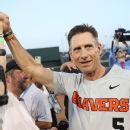3:03 pm | September 6, 2018 | Go to Source | Author:
They said college baseball wouldn’t work in Oregon. Too cold and wet. Not enough talent. Pat Casey heard the talk, but he never listened.
The 59-year-old coach and lifelong Oregonian announced his retirement Thursday after 900 wins and three national championships at Oregon State. Today, the college baseball world listens to him. The national title won two months ago came in Casey’s sixth trip to the College World Series.
Oregon State has won more championships since the turn of the century than any other program. More than the rest of the Pac-12 put together. More than LSU and Cal State Fullerton. As many as Miami and Texas combined.
Think about that. In Corvallis, Oregon.
Casey plans to move into a role as associate athletic director at OSU and help raise money with athletic director Scott Barnes.
“I don’t feel very good about it,” Casey said Thursday. “I feel like I’m a coach. They can dress me up. But I’m a coach.”
Casey said he’s long considered this move. He told his wife, Susan, last winter that this year might be his last. He told Barnes in the spring. He told his assistant coaches when they returned to Oregon from Omaha, Nebraska, in June. They briefly talked him out of it.
“I feel like I’m letting a lot of people down,” said Casey, who fought back tears in delivering his opening statement at a news conference to announce the decision.
So why step aside now? Basically, Casey said, he was worn out and “miserable” at times in recent years. After all, coaching is not supposed to be easy.
“What I expect out of my players,” he said, “I expect out of myself.”
He said he’s “not positive” he can give that any longer.
Not mentioned Thursday was Luke Heimlich, the Beavers’ former star pitcher who pleaded guilty in 2012 to felony child molestation. The Oregonian newspaper reported in June 2017 that Heimlich had admitted to inappropriate contact with his niece, who was 6 at the time of Heimlich’s court proceedings in his home state of Washington.
Heimlich skipped the final two rounds of the 2017 postseason, including the CWS, at which Oregon State finished third. He rejoined the team this year with the support of Casey and Oregon State President Ed Ray.
But Heimlich, who maintained his innocence in multiple interviews, was bypassed again by pro baseball in June despite winning 15 of 16 decisions before the 40-round draft.
The situation took a toll on Casey. Measured in nearly all situations, the coach largely refused to comment publicly on Heimlich’s legal matter over the past 16 months, and said before the Beavers’ super-regional sweep of Minnesota that he was frustrated with the mountain of negative publicity.
“If we could just coach,” Casey said Thursday, “guys would coach for a long time. But that’s not how it works. I get it. It’s life. Life’s not easy.”
It will remain a complex piece of Casey’s legacy.
He stands alongside coaching greats of his generation such as Wayne Graham, Augie Garrido, George Horton, Ray Tanner and Paul Mainieri. They all saw him win at the highest level with a bunch of Oregon kids like Casey all over the diamond.
Horton, in fact, helped shine a light on Casey’s baseball brilliance.
Long written off as a no-win proposition and money drain, baseball at the University of Oregon was slashed it 1981. It returned in 2009, set to replicate the success of the rival school 50 miles to the north. The Ducks, in fact, announced the rebirth of their program in July 2007, weeks after Casey’s second consecutive national title.
And Oregon hired Horton, who had taken Fullerton to the CWS six times and won a title in 2004. He’s not yet brought his Ducks team to Omaha. Casey, meanwhile, returned in 2013 and these past two seasons. His final two teams at Oregon State won 86 percent of their games.
I sat with Horton in the seats near right field at TD Ameritrade Park on the opening weekend this June. Oregon State had lost a day earlier 8-6 to North Carolina in the opening game of the series.
The Beavers looked out of sync. Horton knew the truth, though. They’re not going home any time soon, he said. Casey’s team won four straight to take its side of the bracket, then pulled a late comeback in Game 2 of the finals over Arkansas and beat the Razorbacks 5-0 a night later for the crown.
Casey’s stars in Corvallis included big leaguers Darwin Barney, Jacoby Ellsbury, Cole Gillespie and Michael Conforto. His last team produced first-rounders Nick Madrigal to the White Sox, Trevor Larnach to the Twins and Cadyn Grenier to the Orioles.
And Casey stepped away with impressive talent still in place. Catcher Adley Rutschman, the most outstanding player of the 2018 CWS, returns next spring as arguably the best pro prospect nationally among college players. Batterymate Kevin Abel won a record four games on the mound in Omaha this year and threw a shutout in the clincher.
Thirty years ago, Casey came home to coach at little George Fox University after seven seasons in the minor leagues. He’d played at the University of Portland and hit it big, by Oregon standards, when the Beavers tabbed him to take over in 1995.
Still, outside Casey’s corner of the country, no one paid attention. Oregon State had appeared in the NCAA postseason three times without consequence a decade earlier. Before that, it was a 20-year wait. Once, in 1952, the Beavers had advanced to the College World Series — and they were summarily run out of Omaha by Duke and Texas.
How the tables have turned. Casey’s going out on top. They all listen to him now.
Powered by WPeMatico


